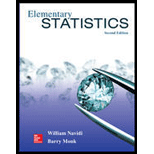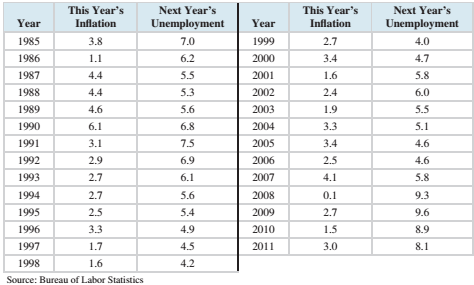
Concept explainers
The relationship between inflation and unemployment is not very strong. However .if we are interested in predicting unemployment, we would probably want to predict next year’s unemployment from this year’s inflation we can construct equation to do this by matching each year? Inflation with the next year’s unemployment. As shown in the following table.

Compute the least-squares line for predicting next year’s unemployment from this year’s inflation
To calculate:
To compute the least squares regression line for the given data set.
Answer to Problem 6CS
Explanation of Solution
Given information:
The following table presents the inflation rate and unemployment rate, both in percent, for the years 1985-2012.
| Year | Inflation | Unemployment |
| 1985 | 3.8 | 7.0 |
| 1986 | 1.1 | 6.2 |
| 1987 | 4.4 | 5.5 |
| 1988 | 4.4 | 5.3 |
| 1989 | 4.6 | 5.6 |
| 1990 | 6.1 | 6.8 |
| 1991 | 3.1 | 7.5 |
| 1992 | 2.9 | 6.9 |
| 1993 | 2.7 | 6.1 |
| 1994 | 2.7 | 5.6 |
| 1995 | 2.5 | 5.4 |
| 1996 | 3.3 | 4.9 |
| 1997 | 1.7 | 4.5 |
| 1998 | 1.6 | 4.2 |
| 1999 | 2.7 | 4.0 |
| 2000 | 3.4 | 4.7 |
| 2001 | 1.6 | 5.8 |
| 2002 | 2.4 | 6.0 |
| 2003 | 1.9 | 5.5 |
| 2004 | 3.3 | 5.1 |
| 2005 | 3.4 | 4.6 |
| 2006 | 2.5 | 4.6 |
| 2007 | 4.1 | 5.8 |
| 2008 | 0.1 | 9.3 |
| 2009 | 2.7 | 9.6 |
| 2010 | 1.5 | 8.9 |
| 2011 | 3.0 | 8.1 |
Formula Used:
The equation for least-square regression line:
Where
The correlation coefficient of a data is given by:
Where,
The standard deviations are given by:
The mean of x is given by:
The mean of y is given by:
Calculation:
The mean of x is given by:
The mean of y is given by:
The data can be represented in tabular form as:
| x | y |  |
 |
 |
 |
| 3.8 | 7.0 | 0.92963 | 0.86421 | 0.94444 | 0.89198 |
| 1.1 | 6.2 | -1.77037 | 3.13421 | 0.14444 | 0.02086 |
| 4.4 | 5.5 | 1.52963 | 2.33977 | -0.55556 | 0.30864 |
| 4.4 | 5.3 | 1.52963 | 2.33977 | -0.75556 | 0.57086 |
| 4.6 | 5.6 | 1.72963 | 2.99162 | -0.45556 | 0.20753 |
| 6.1 | 6.8 | 3.22963 | 10.43051 | 0.74444 | 0.55420 |
| 3.1 | 7.5 | 0.22963 | 0.05273 | 1.44444 | 2.08642 |
| 2.9 | 6.9 | 0.02963 | 0.00088 | 0.84444 | 0.71309 |
| 2.7 | 6.1 | -0.17037 | 0.02903 | 0.04444 | 0.00198 |
| 2.7 | 5.6 | -0.17037 | 0.02903 | -0.45556 | 0.20753 |
| 2.5 | 5.4 | -0.37037 | 0.13717 | -0.65556 | 0.42975 |
| 3.3 | 4.9 | 0.42963 | 0.18458 | -1.15556 | 1.33531 |
| 1.7 | 4.5 | -1.17037 | 1.36977 | -1.55556 | 2.41975 |
| 1.6 | 4.2 | -1.27037 | 1.61384 | -1.85556 | 3.44309 |
| 2.7 | 4.0 | -0.17037 | 0.02903 | -2.05556 | 4.22531 |
| 3.4 | 4.7 | 0.52963 | 0.28051 | -1.35556 | 1.83753 |
| 1.6 | 5.8 | -1.27037 | 1.61384 | -0.25556 | 0.06531 |
| 2.4 | 6.0 | -0.47037 | 0.22125 | -0.05556 | 0.00309 |
| 1.9 | 5.5 | -0.97037 | 0.94162 | -0.55556 | 0.30864 |
| 3.3 | 5.1 | 0.42963 | 0.18458 | -0.95556 | 0.91309 |
| 3.4 | 4.6 | 0.52963 | 0.28051 | -1.45556 | 2.11864 |
| 2.5 | 4.6 | -0.37037 | 0.13717 | -1.45556 | 2.11864 |
| 4.1 | 5.8 | 1.22963 | 1.51199 | -0.25556 | 0.06531 |
| 0.1 | 9.3 | -2.77037 | 7.67495 | 3.24444 | 10.52642 |
| 2.7 | 9.6 | -0.17037 | 0.02903 | 3.54444 | 12.56309 |
| 1.5 | 8.9 | -1.37037 | 1.87791 | 2.84444 | 8.09086 |
| 3.0 | 8.1 | 0.12963 | 0.01680 | 2.04444 | 4.17975 |
| |
|
|
|
Hence, the standard deviation is given by:
And,
Consider,
Hence, the table for calculating coefficient of correlation is given by:
| x | y |  |
 |
 |
| 3.8 | 7.0 | 0.92963 | 0.94444 | 0.87798 |
| 1.1 | 6.2 | -1.77037 | 0.14444 | -0.25572 |
| 4.4 | 5.5 | 1.52963 | -0.55556 | -0.84979 |
| 4.4 | 5.3 | 1.52963 | -0.75556 | -1.15572 |
| 4.6 | 5.6 | 1.72963 | -0.45556 | -0.78794 |
| 6.1 | 6.8 | 3.22963 | 0.74444 | 2.40428 |
| 3.1 | 7.5 | 0.22963 | 1.44444 | 0.33169 |
| 2.9 | 6.9 | 0.02963 | 0.84444 | 0.02502 |
| 2.7 | 6.1 | -0.17037 | 0.04444 | -0.00757 |
| 2.7 | 5.6 | -0.17037 | -0.45556 | 0.07761 |
| 2.5 | 5.4 | -0.37037 | -0.65556 | 0.24280 |
| 3.3 | 4.9 | 0.42963 | -1.15556 | -0.49646 |
| 1.7 | 4.5 | -1.17037 | -1.55556 | 1.82058 |
| 1.6 | 4.2 | -1.27037 | -1.85556 | 2.35724 |
| 2.7 | 4.0 | -0.17037 | -2.05556 | 0.35021 |
| 3.4 | 4.7 | 0.52963 | -1.35556 | -0.71794 |
| 1.6 | 5.8 | -1.27037 | -0.25556 | 0.32465 |
| 2.4 | 6.0 | -0.47037 | -0.05556 | 0.02613 |
| 1.9 | 5.5 | -0.97037 | -0.55556 | 0.53909 |
| 3.3 | 5.1 | 0.42963 | -0.95556 | -0.41053 |
| 3.4 | 4.6 | 0.52963 | -1.45556 | -0.77091 |
| 2.5 | 4.6 | -0.37037 | -1.45556 | 0.53909 |
| 4.1 | 5.8 | 1.22963 | -0.25556 | -0.31424 |
| 0.1 | 9.3 | -2.77037 | 3.24444 | -8.98831 |
| 2.7 | 9.6 | -0.17037 | 3.54444 | -0.60387 |
| 1.5 | 8.9 | -1.37037 | 2.84444 | -3.89794 |
| 3.0 | 8.1 | 0.12963 | 2.04444 | 0.26502 |
| |
|
|
Plugging the values in the formula,
Plugging the values to obtain b1,
Plugging the values to obtain b0,
Hence, the least-square regression line is given by:
Therefore, the least squares regression line for the given data set is
Want to see more full solutions like this?
Chapter 4 Solutions
Elementary Statistics (Text Only)
- Harvard University California Institute of Technology Massachusetts Institute of Technology Stanford University Princeton University University of Cambridge University of Oxford University of California, Berkeley Imperial College London Yale University University of California, Los Angeles University of Chicago Johns Hopkins University Cornell University ETH Zurich University of Michigan University of Toronto Columbia University University of Pennsylvania Carnegie Mellon University University of Hong Kong University College London University of Washington Duke University Northwestern University University of Tokyo Georgia Institute of Technology Pohang University of Science and Technology University of California, Santa Barbara University of British Columbia University of North Carolina at Chapel Hill University of California, San Diego University of Illinois at Urbana-Champaign National University of Singapore McGill…arrow_forwardName Harvard University California Institute of Technology Massachusetts Institute of Technology Stanford University Princeton University University of Cambridge University of Oxford University of California, Berkeley Imperial College London Yale University University of California, Los Angeles University of Chicago Johns Hopkins University Cornell University ETH Zurich University of Michigan University of Toronto Columbia University University of Pennsylvania Carnegie Mellon University University of Hong Kong University College London University of Washington Duke University Northwestern University University of Tokyo Georgia Institute of Technology Pohang University of Science and Technology University of California, Santa Barbara University of British Columbia University of North Carolina at Chapel Hill University of California, San Diego University of Illinois at Urbana-Champaign National University of Singapore…arrow_forwardA company found that the daily sales revenue of its flagship product follows a normal distribution with a mean of $4500 and a standard deviation of $450. The company defines a "high-sales day" that is, any day with sales exceeding $4800. please provide a step by step on how to get the answers in excel Q: What percentage of days can the company expect to have "high-sales days" or sales greater than $4800? Q: What is the sales revenue threshold for the bottom 10% of days? (please note that 10% refers to the probability/area under bell curve towards the lower tail of bell curve) Provide answers in the yellow cellsarrow_forward
- Find the critical value for a left-tailed test using the F distribution with a 0.025, degrees of freedom in the numerator=12, and degrees of freedom in the denominator = 50. A portion of the table of critical values of the F-distribution is provided. Click the icon to view the partial table of critical values of the F-distribution. What is the critical value? (Round to two decimal places as needed.)arrow_forwardA retail store manager claims that the average daily sales of the store are $1,500. You aim to test whether the actual average daily sales differ significantly from this claimed value. You can provide your answer by inserting a text box and the answer must include: Null hypothesis, Alternative hypothesis, Show answer (output table/summary table), and Conclusion based on the P value. Showing the calculation is a must. If calculation is missing,so please provide a step by step on the answers Numerical answers in the yellow cellsarrow_forwardShow all workarrow_forward
- Algebra & Trigonometry with Analytic GeometryAlgebraISBN:9781133382119Author:SwokowskiPublisher:Cengage
 Elementary Linear Algebra (MindTap Course List)AlgebraISBN:9781305658004Author:Ron LarsonPublisher:Cengage Learning
Elementary Linear Algebra (MindTap Course List)AlgebraISBN:9781305658004Author:Ron LarsonPublisher:Cengage Learning Trigonometry (MindTap Course List)TrigonometryISBN:9781305652224Author:Charles P. McKeague, Mark D. TurnerPublisher:Cengage Learning
Trigonometry (MindTap Course List)TrigonometryISBN:9781305652224Author:Charles P. McKeague, Mark D. TurnerPublisher:Cengage Learning  Linear Algebra: A Modern IntroductionAlgebraISBN:9781285463247Author:David PoolePublisher:Cengage Learning
Linear Algebra: A Modern IntroductionAlgebraISBN:9781285463247Author:David PoolePublisher:Cengage Learning
 Glencoe Algebra 1, Student Edition, 9780079039897...AlgebraISBN:9780079039897Author:CarterPublisher:McGraw Hill
Glencoe Algebra 1, Student Edition, 9780079039897...AlgebraISBN:9780079039897Author:CarterPublisher:McGraw Hill





